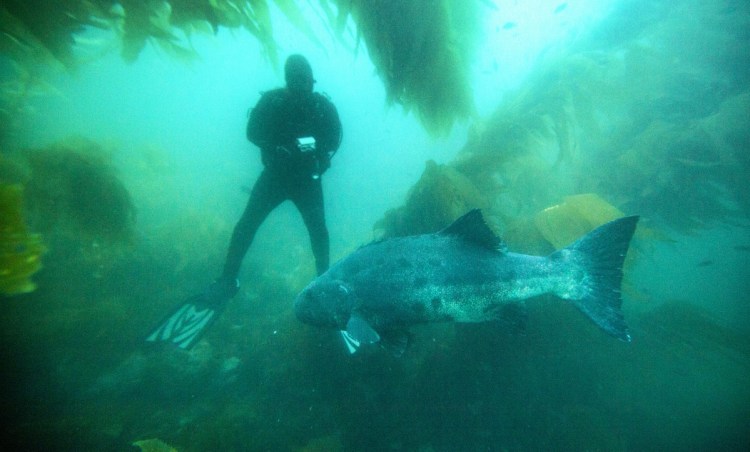AVALON, Calif. — As the sun rose over this harbor town on Santa Catalina Island, four scuba divers with cameras and notepads finned toward canopies of undulating kelp.
The seaweed off Santa Catalina Island was teeming with small fish that flashed kaleidoscopically vivid colors. The small fish attracted larger fish – opaleye, kelp bass, sheepshead and bright orange garibaldi, the California state marine fish.
But they were of little interest to the divers from the University of California, Santa Barbara and the Aquarium of the Pacific, who descended in search of something much bigger.
Their mission: to confirm reports of unusually large numbers of giant sea bass gathering at Avalon’s Casino Dive Park, one of the most popular scuba diving sites in California.
It’s part of an effort by scientists to understand and encourage the remarkable but still fragile comeback for one of the biggest fish of all, which all but disappeared from the Southern California coast due to overfishing.
Giant sea bass can live at least 70 years, grow to 7 feet in length and weigh up to 560 pounds. The breeding population of the giant sea bass – which is listed as critically endangered by the International Union for Conservation of Nature – is believed to be only about 500 individuals.
Three decades ago, there were no giant sea bass returning to spawn around Catalina each year, scientists say.
Today, there are about 40 to 50, and many are under 20 years old, which suggests they were hatched around the time that catching them was banned in California.
The divers’ depth gauges read 30 feet when one of the silvery behemoths, with black spots, pouty lips and a downward mouth, emerged from the kelp and almost bumped noses with Douglas McCauley, a marine biologist at UCSB.
Within a few hours, the group documented nine more of the bottom-dwelling fish within a few hundred yards of Avalon’s curving, cafe-lined promenade – one of the largest gatherings of spawning giant sea bass seen in the area since the 1970s, when the species was driven to the brink.
Ashore, people asked, “What’d you see down there?”
“We saw a remarkable number of giant sea bass as rare as black rhinos,” McCauley said with a smile. “That’s encouraging, because this species is an important part of the history and culture of California, and it appears to be making a comeback just 22 miles off the mainland.”
Since spot patterns on the flanks of individual giant sea bass are unique and can be read like natural bar codes, the divers took photos of the right and left sides of specimens they encountered.
The photos will be uploaded to Spotting Giant Sea Bass, a new website launched by the Aquarium of the Pacific where researchers and recreational divers can share information and images about when and where individual fish were seen. The website will make matches by using pattern-recognition algorithms first developed by astrophysicists to spot patterns in star constellations.
With more than 1 million dives logged annually in California, makers of the website hope it will help with the recovery of the species by identifying their spawning grounds, calculating how far they move, determining whether they inhabit protected marine areas, and observing the threats they encounter in their travels.
The largest carnivores in the kelp forests off Southern California, giant sea bass were once very common, scientists say. But their slow reproduction and tendency to aggregate in large groups made them vulnerable to commercial fishing and spear-slinging divers. The few that remained were hunted as trophies until the state in 1982 made it a misdemeanor to kill the fish (commercial fishers who accidentally capture giant sea bass in gill nets are not prosecuted).
Since the species was given protection under state law, fishers have mostly kept their distance – though the practice is still memorialized in bygone snapshots hung in Southern California bait shops showing proud anglers and spear fishermen beside 500-pound catches.
Giant sea bass snared in gill nets occasionally wind up in local fish markets. Giant sea bass sold for $19.99 a pound at a market in Ventura earlier this month, according to a conservationist who visited the business.
Historically, the fish were found from Humboldt Bay in Northern California to Baja California. The largest on record measured 71/2 feet and 563 pounds.
They congregate around the Channel Islands from April through October to spawn, then disappear each winter. No one knows where they go.
That may change, however. A research team led by Larry Allen, a professor of marine biology at Cal State Northridge, recently attached acoustic transmitter dart tags to six giant sea bass off Catalina to monitor their movements.
Send questions/comments to the editors.



Success. Please wait for the page to reload. If the page does not reload within 5 seconds, please refresh the page.
Enter your email and password to access comments.
Hi, to comment on stories you must . This profile is in addition to your subscription and website login.
Already have a commenting profile? .
Invalid username/password.
Please check your email to confirm and complete your registration.
Only subscribers are eligible to post comments. Please subscribe or login first for digital access. Here’s why.
Use the form below to reset your password. When you've submitted your account email, we will send an email with a reset code.